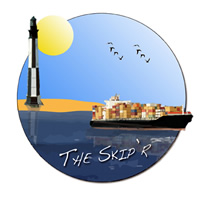Abstract:
Similar to the evolutionary process for living organisms, marine navigation systems are becoming increasingly complex and sophisticated. Both by design and function, shipboard and shore-based navigation systems are no longer individual equipment components operating independently. Instead, the trend is toward integration, data fusion and synergy. One example of this are new Performance Standards being considered by IMO to achieve a "harmonized" presentation of all navigation-related information on the display of an integrated navigation system (INS). Unlike a dedicated display for ECDIS or radar, the new INS displays will be a task-oriented composite presentations that enable the mariner to configure the display for an operational situation by selecting specific chart, radar, radar plotting aids (ARPA) and AIS information that is required for the task-at-hand.
This paper gives a brief overview of the trend toward the development of INS. In addition to a brief summary of IMO performance standards for navigation equipment/systems, specific mention is made about a BSH (Germany) report on the "Functional Scope and Model of INS." A discussion is provided about the challenges of providing navigation safety information that goes beyond traditional boundaries of products and services. Currently, many agencies continue to produce individual products and services on a component basis. Hydrographic offices grapple with trying to provide multiple products and services for paper charts, raster navigational charts (RNCs) and electronic navigational charts (ENCs) while a same time, Coast Guard and Maritime Safety agencies focus on improving Aids-to-Navigation (AtoN), Vessel Traffic Services (VTS), AIS networks -- and more recently, port security. In some respects, the continued concentration on separate products and services represents an organizational reluctance to change. This in turn, results in a fragmented, sub-optimal approach to the safety-of-navigation caused by the inability to provide mariners with "seamless" information at reasonable cost. In particular, hydrographic offices must be willing to recognize that chart information can no longer be considered to be separate, individual products. When it comes to the provision and use of chart-related information for use in an INS, the focus needs to shift to what information is actually desired, how it will be provided, what other information it will be used with, and whether it is truly up-todate.
Introduction
Similar to the evolutionary process for living organisms, marine navigation systems are becoming increasingly complex and sophisticated. Both by design and function, shipboard and shore-based navigation systems are no longer individual equipment components operating independently. Instead, the trend of manufacturers and users is toward system integration, data fusion and synergy. In the broadest sense, a "system" can be defined as: "a group or combination of interrelated, interdependent, or interacting elements forming a collective entity." [1] More specific to shipborne navigation, Bowditch defines an integrated navigation system (or integrated bridge system) as "a combination of equipment and software which uses interconnected controls and displays to present a comprehensive site of navigational information to the mariner." [2]
Given this ongoing process of integration we need to ask ourselves some basic questions: where is this integration taking us and what concerns might we have as this evolutionary process unfolds. In this paper we examine the trends in navigation system integration and the status of international standards that give guidance on how such systems should evolve. We also note a key paradox in systems development that has to be confronted in order for these developments to bear the kind of fruit they promise.
Although it appears initially as counter-intuitive, it is a given in systems theory that full system optimization can only take place when subsystems are sub-optimal. [3] A corollary would be that the more independent each subsystem is, the more sub-optimal the full system will be. This is one of the great paradoxes of systems theory. The more that each subsystem is treated independently the more dysfunctional the overall system behaves. These principles are well embedded in manufacturing and other high throughput systems where, unless well managed, subsystems create problems downstream resulting in poor overall performance. This type of evolutionary process is clearly taking place for shipboard navigation systems. As we go forward with increased integration of navigation subsystems we need to be cautious about how the subsystems will operate together and about what assumptions one subsystem makes about the behavior of another. This is particularly true for Integrated Navigation Systems for, as we show here, the subsystems were all developed independently.
Separate Equipment -> Integrated Systems
. . .Continue to read rest of article (PDF).
Captain Joseph F. Ryan is an internationally recognized Subject Matter Expert in Computerized Applications for Marine Navigation, particularly the interfacing and integration of the Automatic Identification System (AIS), the implementation of electronic charting technology, and the presentation of navigation-related information for navigation and Command and Control (C2) systems.
©Copyright - All Rights Reserved
DO NOT REPRODUCE WITHOUT WRITTEN PERMISSION BY AUTHOR.









